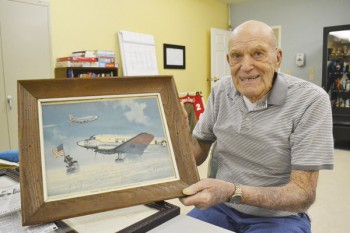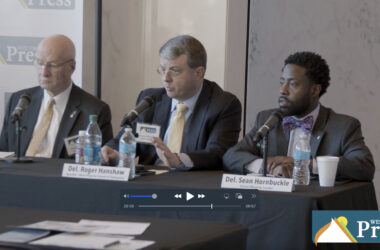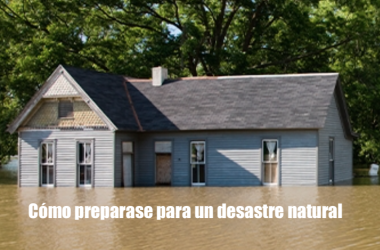
John Philip Strider, one of two living members of the Operation Deep Freeze II expedition, with a photo of the Que Sera Sera, the plane he was on during the expedition.
MARTINSBURG, W.Va. — In the comfort of the Elmcroft senior living center, 85-year-old John Philip Strider, retired chief petty officer in the U.S. Navy, can still recall every detail of the historic Operation Deep Freeze II expedition to Antarctica.
Strider said he remembers sitting and sharing a meal with a few other members of his unit stationed in Tennessee in May of 1955 and hearing that the commanding officers were looking for volunteers to go to Antarctica.
The then-25-year-old Strider joined the newly developed VX-6 squadron for the mission, Operation Deep Freeze II, an experimental venture by the U. S. military to find out if aircraft could operate at the South Pole.
From Tennessee, Strider and the other men in VX-6 flew to Alameda, California, from there to Hawaii, then Canton, the Christmas Islands, Fiji and finally Christ Church, New Zealand, the unit’s last stop before flying to the South pole.
“Getting there was the big thing,” Strider said. “We had to stop for gas, but we never stopped for crew rest because we had a big enough crew that we just slept on the plane and relieved each other of duties.”
Although the unit was outfitted with four DC-3 aircraft, two C-54 aircraft and some sea planes, Strider said much of the equipment they had to work with was outdated and only the C-54s were capable of making it to the South Pole-where they had to land on a runway made of ice.
“It was a very makeshift operation. The equipment we had was way outdated, and a lot of it had been rebuilt or re-manufactured. The fuel system looked like a plumber might have got hold of it. It was very crude,” he said.
Strider said that he was not told why he was going to Antarctica, but said his commanders made it clear that the mission was part of an international race to get to the South Pole first.
“Admiral (Richard E.) Byrd was on Deep Freeze I. He never did make it to the pole. We flew him over it, but he never did set foot on it. On Deep Freeze II, he got ill and died and was replaced by rear admiral George Dufek. (Dufek) made it clear that we were to beat the Russians to the pole at all cost, and we did.”
Strider said he was the first person out of the plane to set foot on the South Pole, since it was his job to secure the landing gear.
Strider said the climate was so cold that his gauges couldn’t get an accurate reading, but it was colder than minus 50 degrees Fahrenheit.
He spent 48 minutes at the South Pole, planting an American flag and radar equipment.
Other members of the unit were concerned that the plane may not operate in the extreme cold and at such a high elevation-10,000 feet altitude.
Strider said the strong, chilling winds blew snow into the belly of the plane, and crew members had to place heaters under the engine.
Upon a safe return from the Operation Deep Freeze II expedition, Strider said he did other things while in the Navy, including tours in the Middle East and India.
“I was a country boy and had never been out of the States, and here I was going to Hawaii, the Christmas Islands and Canton. Christ Church, New Zealand, was such a beautiful place, it was almost like being in heaven. I saw the world, well, at least half of it,” he said. “The only place I didn’t get to go that I wanted to was Singapore, and the only thing I’d like to see again is the Taj Mahal.”
Documentary filmmaker Thomas Henderson, proprietor of Graceful Willows Productions, came to interview Strider at the nursing home to preserve his firsthand account of the historic mission.
Henderson said he had made other films about Antarctica in the past before becoming interested in the aviation aspect of it.
“I started interviewing people (for the film) last November. This is the 31st interview, with quite a few more to go,” Henderson said. “(I’m interviewing) both military and civilian people. A lot of (the flights to Antarctica) were done by the military, so I’m talking to quite a number of those folks. I’ve actually interviewed people who were on the 1939 Byrd expedition.”
Henderson said he is expecting the film to be completed by the spring or summer of 2016.
According to Henderson, now is the time to interview people who went on the early expeditions, since they are advancing in age.
“Now is the time, if we’re going to do it. The more I get into this story, the more interesting it is and the more I find people want the story told. A lot of the folks (who went on these missions) feel they’ve been somewhat overlooked at this point, so I feel more of an obligation to get their stories out there,” he said.
Henderson has a Kickstarter fund for the film, “Ice Eagles: An Account of American Aviation in Antarctica.” Through the crowd-funding site, $9,491 has been raised of the $9,600 goal needed to finish making the film.
For more information about the film, visit http://kck.st/1x4W8Se.
-Staff writer Mary Stortstrom can be reached at 304-725-6581 or www.twitter.com/mstortstromJN.





